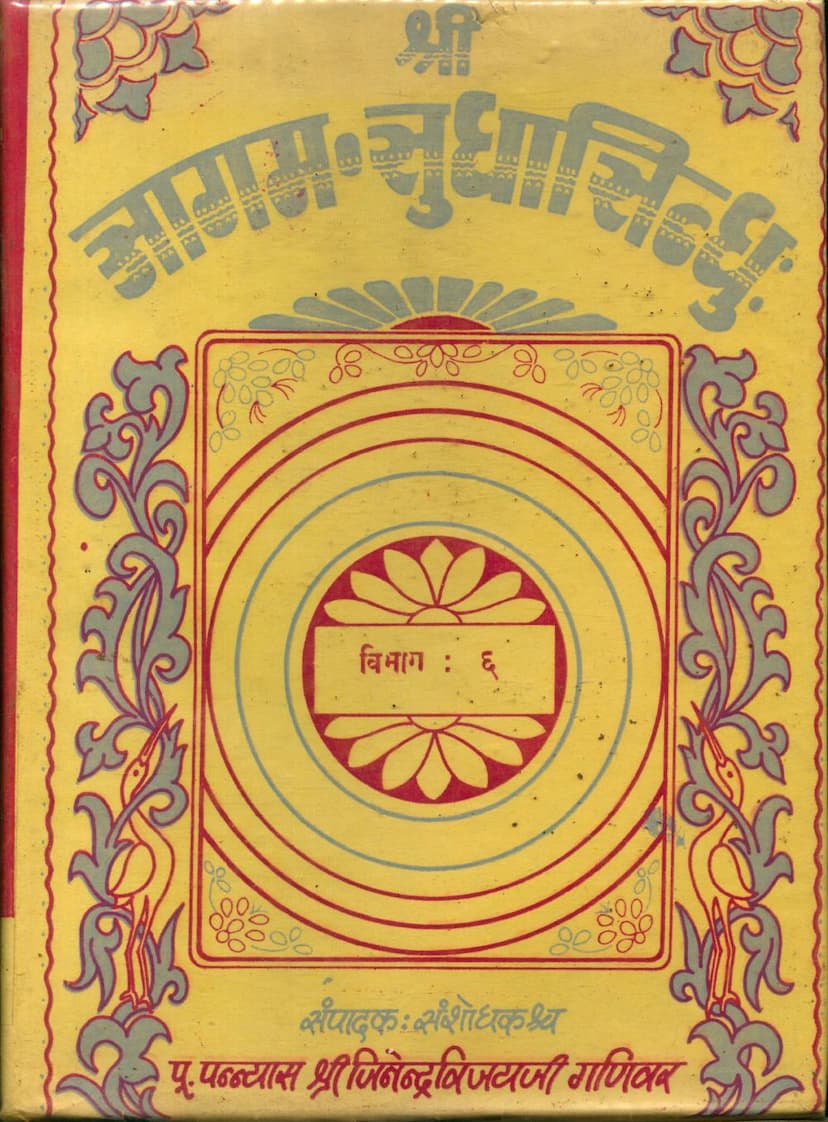Agam Sudha Sindhu Part 06
Added to library: September 1, 2025

Summary
This is a comprehensive summary of the Jain text "Agam Sudha Sindhu Part 06" by Jinendravijay Gani, published by Harshpushpamrut Jain Granthmala. The text primarily focuses on the Shrimat Prajnapana Sutra.
Overall Purpose and Context:
The "Agam Sudha Sindhu" series aims to present the core Agamic scriptures of Jainism in a systematic and accessible manner. Part 06 is dedicated to the Prajnapana Sutra, a significant scripture that delves into intricate details of Jain philosophy, particularly concerning the nature of souls (jivas) and non-living substances (ajivas), their qualities, states, and interactions.
Key Aspects and Content:
The provided text reveals the structure and content of this volume, which is a compilation and commentary on the Prajnapana Sutra. Here's a breakdown:
- Compilation and Editing: The work is presented as the sixth part of the "Agam Sudha Sindhu" series. It is the result of meticulous research and editing by Panannyas Shri Jinendravijay Gani, under the guidance of revered Acharya Dev Shrimal Vijaykapoor Surishwarji Maharaj and Acharya Dev Shrimal Vijayamritsurishwarji Maharaj.
- Source Text: The primary text is the Prajnapana Sutra, attributed to Shruthsthavir Arya Shri Shyamacharya Ji Maharaj.
- Commentary and Basis: The editing and compilation heavily rely on the commentary of Shrimad Acharya Shrimad Malayagiri Ji Maharaj. It also utilizes other valuable publications such as "Shrimad Agam Manjusha" edited by Pujya Agamoddharak Acharya Dev Shri Sagarannandasurishwarji Maharaj, publications by Shri Agamoday Samiti, and Shri Mahavir Vidyalaya.
- Structure of the Prajnapana Sutra within the Text: The text is organized into various "Padas" (sections or chapters), indicating a detailed exploration of concepts. The table of contents (Anukramanika) on page 9 lists these Padas, covering a wide range of topics:
- Prakarana (Chapter/Section): This seems to be the main classification, with Padas within.
- Specific Topics Covered in Padas:
- Sthan (Place/Location)
- Alpabahutva (Relative quantity or number)
- Sthiti (Duration/Lifespan)
- Paryay (Modification/Change)
- Viyutkranti (Descent/Rebirth in different realms)
- Uchchvas (Respiration)
- Samjna (Consciousness/Perception)
- Yoni (Origin/Source)
- Charama (Final birth)
- Bhasha (Language/Speech)
- Sharir (Body)
- Parinam (Transformation/Result)
- Kashay (Passions)
- Indriya (Sense-organs)
- Prayog (Action/Application)
- Leshya (Subtle karmic colors/dispositions)
- Kayasthiti (Body duration)
- Samyaktva (Right faith)
- Antakriya (Cessation of karma)
- Avagahan-Samsthan (Spatial extent/form of beings)
- Kriya (Action)
- Karmaprakriti-bandh (Bonding of karma types)
- Karmaveda (Karma states)
- Ahar (Food/Sustenance)
- Upyog (Utilization/Consciousness function)
- Pashyatta (Seeing/Perception)
- Samyam-Yoga (Control and mental/verbal/physical activities)
- Jnanaparinam (Consequences of knowledge)
- Pravichar (Discourse/Explanation)
- Vedana (Sensation/Feeling)
- Samudghat (Cosmic process/escape of body)
- Categorization of Agamas: The introductory sections (pages 4-7) highlight the importance of the Agamas and their classification within the Shvetambara tradition, mentioning the 45 Mool Agamas and their division into six categories: Anga, Upanga, Punnaya, Cheda, Mool Sutra, and Chulika Sutra.
- Detailed Discourse on Substances and Souls: The text provides extensive explanations on various topics, including:
- Pudgala (Matter): Detailed analysis of its properties (color, smell, taste, touch), forms (Varga), and their combinations.
- Jiva (Soul): Classification of souls based on senses (Ekendriya to Panchendriya), their states of existence (Samsara, Siddha), transmigration, and the nature of their karma.
- Karma Theory: Extensive discussion on karma, its binding, states (Veda), and the process of liberation.
- Leshya: Detailed explanations of the six Leshyas (Kriyakriya, Neela, Kakhu, Tejus, Padma, Shukla) and their permutations within different life forms.
- Samyaktva and Charitra: The path to liberation through Right Faith, Right Knowledge, and Right Conduct.
- Causality and Interdependence: The text likely explores the principles of cause and effect in the context of karmic actions and spiritual progress.
- Editorial Approach: The publishers express gratitude to various sources and explain their effort to reconcile textual variations (pathantara) from commentaries with the original texts, presenting them in a user-friendly format.
- Dedication: The sixth volume is dedicated to Pujyapada Acharya Devesh Shrimad Vijaymeshwarisurishwarji Maharaj for their inspiration and guidance, who passed away before the completion of the Agam Sangraha project.
- Commitment to Jain Scriptures: The publication emphasizes the importance of making these foundational texts available to the Jain community for study and adherence to the path of liberation as laid down by Lord Mahavir.
- Correction Sheet (Shuddhipatraka): Page 10 and 11 show a "Shuddhipatraka" (list of corrections), indicating a rigorous editorial process to ensure accuracy.
Significance:
This volume is a scholarly endeavor to preserve and disseminate the profound teachings of the Prajnapana Sutra. It serves as a vital resource for Jains seeking to understand the intricate philosophical underpinnings of their religion, particularly the detailed classification and analysis of souls, karma, and the path to spiritual liberation. The work underscores the commitment of the publisher and the editor to furthering Jain education and preserving the sanctity of the Agamic literature.